Zhengjue Wang
Discovering Fine-Grained Visual-Concept Relations by Disentangled Optimal Transport Concept Bottleneck Models
May 12, 2025



Abstract:Concept Bottleneck Models (CBMs) try to make the decision-making process transparent by exploring an intermediate concept space between the input image and the output prediction. Existing CBMs just learn coarse-grained relations between the whole image and the concepts, less considering local image information, leading to two main drawbacks: i) they often produce spurious visual-concept relations, hence decreasing model reliability; and ii) though CBMs could explain the importance of every concept to the final prediction, it is still challenging to tell which visual region produces the prediction. To solve these problems, this paper proposes a Disentangled Optimal Transport CBM (DOT-CBM) framework to explore fine-grained visual-concept relations between local image patches and concepts. Specifically, we model the concept prediction process as a transportation problem between the patches and concepts, thereby achieving explicit fine-grained feature alignment. We also incorporate orthogonal projection losses within the modality to enhance local feature disentanglement. To further address the shortcut issues caused by statistical biases in the data, we utilize the visual saliency map and concept label statistics as transportation priors. Thus, DOT-CBM can visualize inversion heatmaps, provide more reliable concept predictions, and produce more accurate class predictions. Comprehensive experiments demonstrate that our proposed DOT-CBM achieves SOTA performance on several tasks, including image classification, local part detection and out-of-distribution generalization.
HICEScore: A Hierarchical Metric for Image Captioning Evaluation
Jul 26, 2024



Abstract:Image captioning evaluation metrics can be divided into two categories, reference-based metrics and reference-free metrics. However, reference-based approaches may struggle to evaluate descriptive captions with abundant visual details produced by advanced multimodal large language models, due to their heavy reliance on limited human-annotated references. In contrast, previous reference-free metrics have been proven effective via CLIP cross-modality similarity. Nonetheless, CLIP-based metrics, constrained by their solution of global image-text compatibility, often have a deficiency in detecting local textual hallucinations and are insensitive to small visual objects. Besides, their single-scale designs are unable to provide an interpretable evaluation process such as pinpointing the position of caption mistakes and identifying visual regions that have not been described. To move forward, we propose a novel reference-free metric for image captioning evaluation, dubbed Hierarchical Image Captioning Evaluation Score (HICE-S). By detecting local visual regions and textual phrases, HICE-S builds an interpretable hierarchical scoring mechanism, breaking through the barriers of the single-scale structure of existing reference-free metrics. Comprehensive experiments indicate that our proposed metric achieves the SOTA performance on several benchmarks, outperforming existing reference-free metrics like CLIP-S and PAC-S, and reference-based metrics like METEOR and CIDEr. Moreover, several case studies reveal that the assessment process of HICE-S on detailed captions closely resembles interpretable human judgments.Our code is available at https://github.com/joeyz0z/HICE.
MeaCap: Memory-Augmented Zero-shot Image Captioning
Mar 06, 2024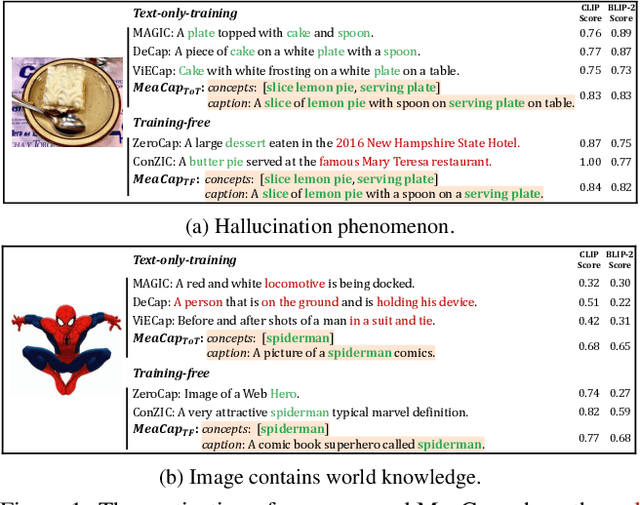

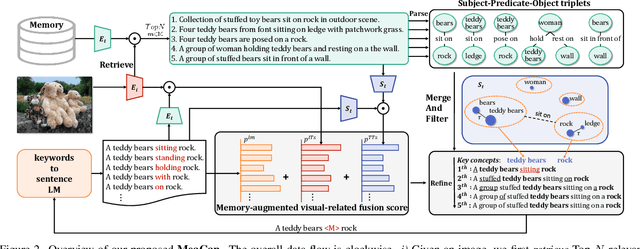

Abstract:Zero-shot image captioning (IC) without well-paired image-text data can be divided into two categories, training-free and text-only-training. Generally, these two types of methods realize zero-shot IC by integrating pretrained vision-language models like CLIP for image-text similarity evaluation and a pre-trained language model (LM) for caption generation. The main difference between them is whether using a textual corpus to train the LM. Though achieving attractive performance w.r.t. some metrics, existing methods often exhibit some common drawbacks. Training-free methods tend to produce hallucinations, while text-only-training often lose generalization capability. To move forward, in this paper, we propose a novel Memory-Augmented zero-shot image Captioning framework (MeaCap). Specifically, equipped with a textual memory, we introduce a retrieve-then-filter module to get key concepts that are highly related to the image. By deploying our proposed memory-augmented visual-related fusion score in a keywords-to-sentence LM, MeaCap can generate concept-centered captions that keep high consistency with the image with fewer hallucinations and more world-knowledge. The framework of MeaCap achieves the state-of-the-art performance on a series of zero-shot IC settings. Our code is available at https://github.com/joeyz0z/MeaCap.
SnapCap: Efficient Snapshot Compressive Video Captioning
Jan 10, 2024Abstract:Video Captioning (VC) is a challenging multi-modal task since it requires describing the scene in language by understanding various and complex videos. For machines, the traditional VC follows the "imaging-compression-decoding-and-then-captioning" pipeline, where compression is pivot for storage and transmission. However, in such a pipeline, some potential shortcomings are inevitable, i.e., information redundancy resulting in low efficiency and information loss during the sampling process for captioning. To address these problems, in this paper, we propose a novel VC pipeline to generate captions directly from the compressed measurement, which can be captured by a snapshot compressive sensing camera and we dub our model SnapCap. To be more specific, benefiting from the signal simulation, we have access to obtain abundant measurement-video-annotation data pairs for our model. Besides, to better extract language-related visual representations from the compressed measurement, we propose to distill the knowledge from videos via a pre-trained CLIP with plentiful language-vision associations to guide the learning of our SnapCap. To demonstrate the effectiveness of SnapCap, we conduct experiments on two widely-used VC datasets. Both the qualitative and quantitative results verify the superiority of our pipeline over conventional VC pipelines. In particular, compared to the "caption-after-reconstruction" methods, our SnapCap can run at least 3$\times$ faster, and achieve better caption results.
ConZIC: Controllable Zero-shot Image Captioning by Sampling-Based Polishing
Mar 09, 2023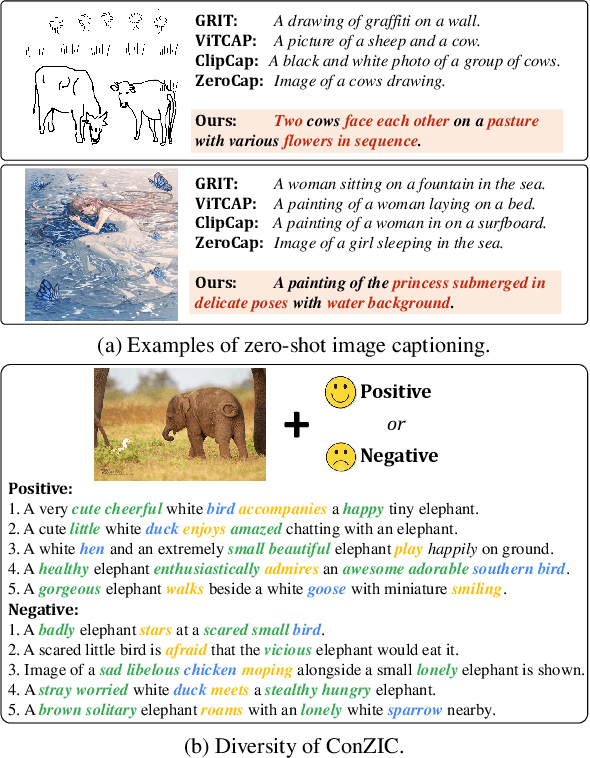

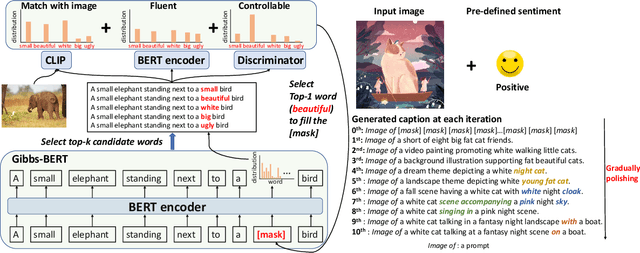

Abstract:Zero-shot capability has been considered as a new revolution of deep learning, letting machines work on tasks without curated training data. As a good start and the only existing outcome of zero-shot image captioning (IC), ZeroCap abandons supervised training and sequentially searches every word in the caption using the knowledge of large-scale pretrained models. Though effective, its autoregressive generation and gradient-directed searching mechanism limit the diversity of captions and inference speed, respectively. Moreover, ZeroCap does not consider the controllability issue of zero-shot IC. To move forward, we propose a framework for Controllable Zero-shot IC, named ConZIC. The core of ConZIC is a novel sampling-based non-autoregressive language model named GibbsBERT, which can generate and continuously polish every word. Extensive quantitative and qualitative results demonstrate the superior performance of our proposed ConZIC for both zero-shot IC and controllable zero-shot IC. Especially, ConZIC achieves about 5x faster generation speed than ZeroCap, and about 1.5x higher diversity scores, with accurate generation given different control signals.
Block Modulating Video Compression: An Ultra Low Complexity Image Compression Encoder for Resource Limited Platforms
May 07, 2022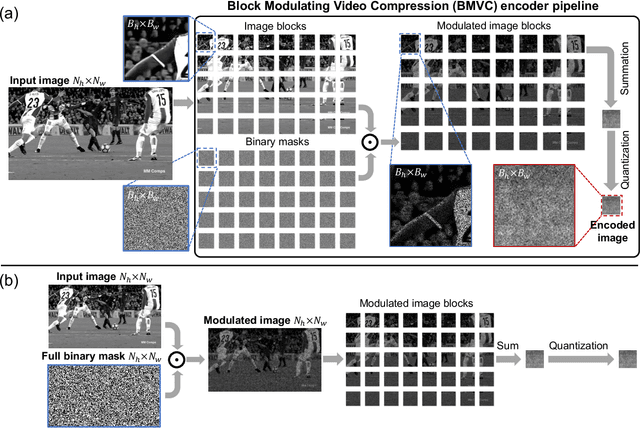
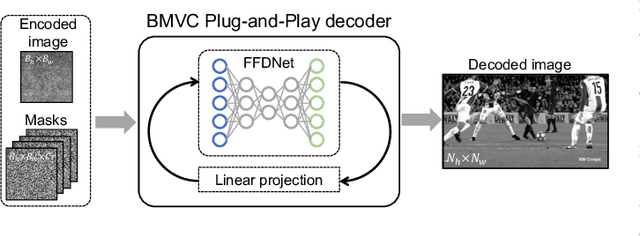


Abstract:We consider the image and video compression on resource limited platforms. An ultra low-cost image encoder, named Block Modulating Video Compression (BMVC) with an encoding complexity ${\cal O}(1)$ is proposed to be implemented on mobile platforms with low consumption of power and computation resources. We also develop two types of BMVC decoders, implemented by deep neural networks. The first BMVC decoder is based on the Plug-and-Play (PnP) algorithm, which is flexible to different compression ratios. And the second decoder is a memory efficient end-to-end convolutional neural network, which aims for real-time decoding. Extensive results on the high definition images and videos demonstrate the superior performance of the proposed codec and the robustness against bit quantization.
Memory-Efficient Network for Large-scale Video Compressive Sensing
Mar 05, 2021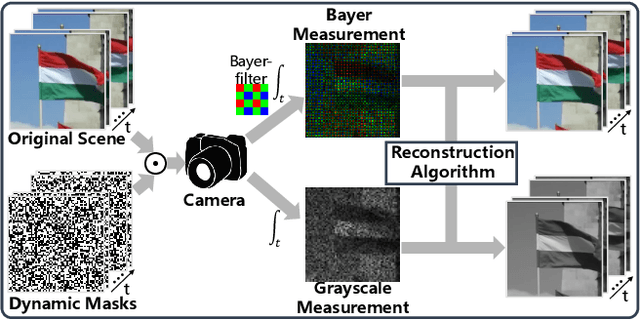

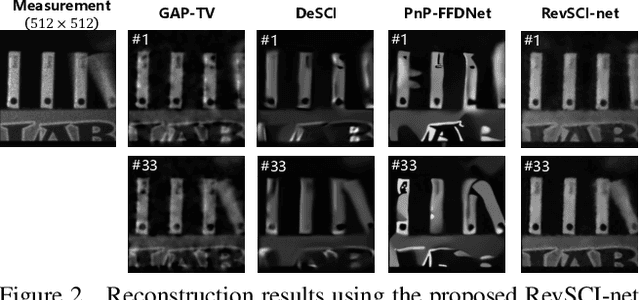
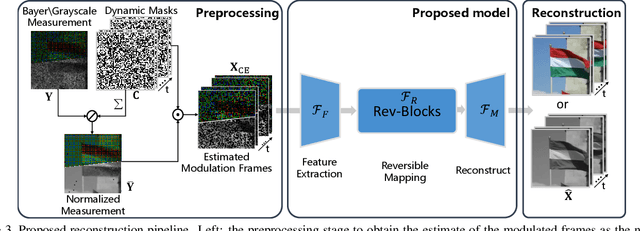
Abstract:Video snapshot compressive imaging (SCI) captures a sequence of video frames in a single shot using a 2D detector. The underlying principle is that during one exposure time, different masks are imposed on the high-speed scene to form a compressed measurement. With the knowledge of masks, optimization algorithms or deep learning methods are employed to reconstruct the desired high-speed video frames from this snapshot measurement. Unfortunately, though these methods can achieve decent results, the long running time of optimization algorithms or huge training memory occupation of deep networks still preclude them in practical applications. In this paper, we develop a memory-efficient network for large-scale video SCI based on multi-group reversible 3D convolutional neural networks. In addition to the basic model for the grayscale SCI system, we take one step further to combine demosaicing and SCI reconstruction to directly recover color video from Bayer measurements. Extensive results on both simulation and real data captured by SCI cameras demonstrate that our proposed model outperforms previous state-of-the-art with less memory and thus can be used in large-scale problems. The code is at https://github.com/BoChenGroup/RevSCI-net.
MetaSCI: Scalable and Adaptive Reconstruction for Video Compressive Sensing
Mar 02, 2021

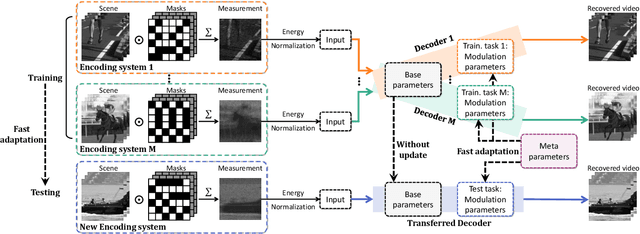

Abstract:To capture high-speed videos using a two-dimensional detector, video snapshot compressive imaging (SCI) is a promising system, where the video frames are coded by different masks and then compressed to a snapshot measurement. Following this, efficient algorithms are desired to reconstruct the high-speed frames, where the state-of-the-art results are achieved by deep learning networks. However, these networks are usually trained for specific small-scale masks and often have high demands of training time and GPU memory, which are hence {\bf \em not flexible} to $i$) a new mask with the same size and $ii$) a larger-scale mask. We address these challenges by developing a Meta Modulated Convolutional Network for SCI reconstruction, dubbed MetaSCI. MetaSCI is composed of a shared backbone for different masks, and light-weight meta-modulation parameters to evolve to different modulation parameters for each mask, thus having the properties of {\bf \em fast adaptation} to new masks (or systems) and ready to {\bf \em scale to large data}. Extensive simulation and real data results demonstrate the superior performance of our proposed approach. Our code is available at {\small\url{https://github.com/xyvirtualgroup/MetaSCI-CVPR2021}}.
Variational Hetero-Encoder Randomized Generative Adversarial Networks for Joint Image-Text Modeling
May 18, 2019

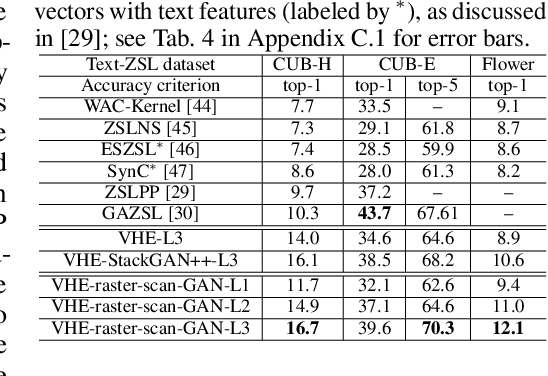
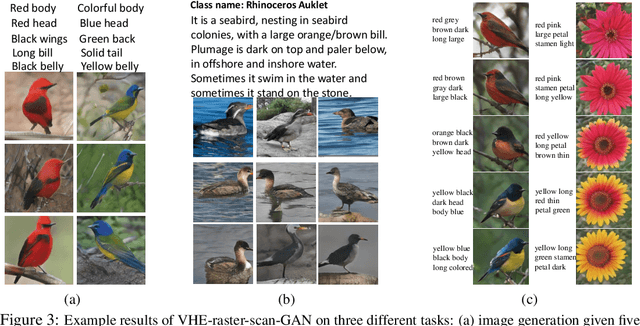
Abstract:For bidirectional joint image-text modeling, we develop variational hetero-encoder (VHE) randomized generative adversarial network (GAN) that integrates a probabilistic text decoder, probabilistic image encoder, and GAN into a coherent end-to-end multi-modality learning framework. VHE randomized GAN (VHE-GAN) encodes an image to decode its associated text, and feeds the variational posterior as the source of randomness into the GAN image generator. We plug three off-the-shelf modules, including a deep topic model, a ladder-structured image encoder, and StackGAN++, into VHE-GAN, which already achieves competitive performance. This further motivates the development of VHE-raster-scan-GAN that generates photo-realistic images in not only a multi-scale low-to-high-resolution manner, but also a hierarchical-semantic coarse-to-fine fashion. By capturing and relating hierarchical semantic and visual concepts with end-to-end training, VHE-raster-scan-GAN achieves state-of-the-art performance in a wide variety of image-text multi-modality learning and generation tasks. PyTorch code is provided.
 Add to Chrome
Add to Chrome Add to Firefox
Add to Firefox Add to Edge
Add to Edge